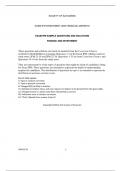Examen
EXAM IFM INVESTMENT AND FINANCIAL MARKETS
- Cours
- Établissement
These questions and solutions are based on material from the Corporate Finance textbook by Berk/DeMarzo (Learning Outcomes 1-5 of the Exam IFM syllabus) and two study notes, IFM-21-18 and IFM-22-18. Questions 1-33 are from Corporate Finance and Questions 34–43 are from the study notes. Th...
[Montrer plus]



